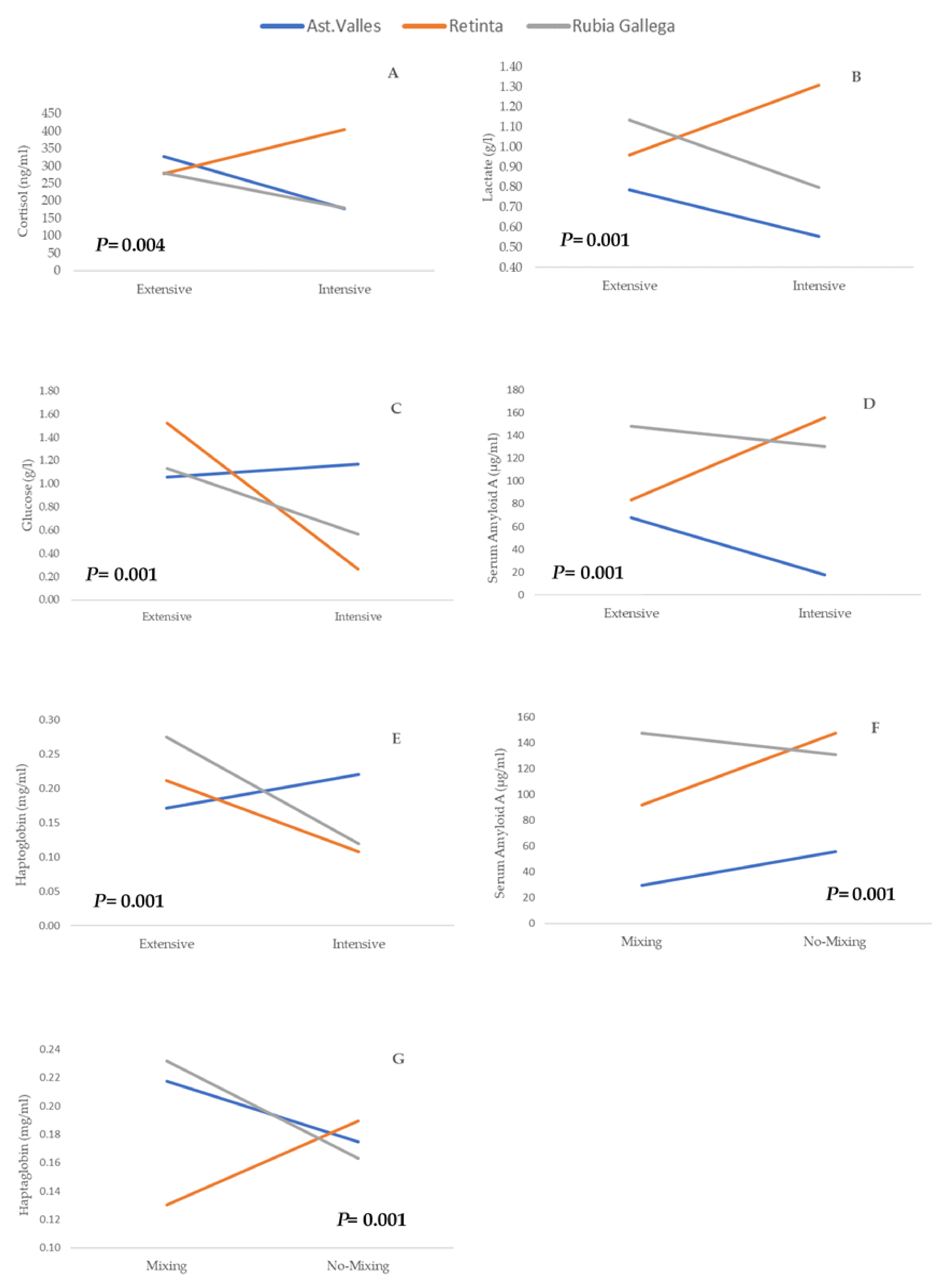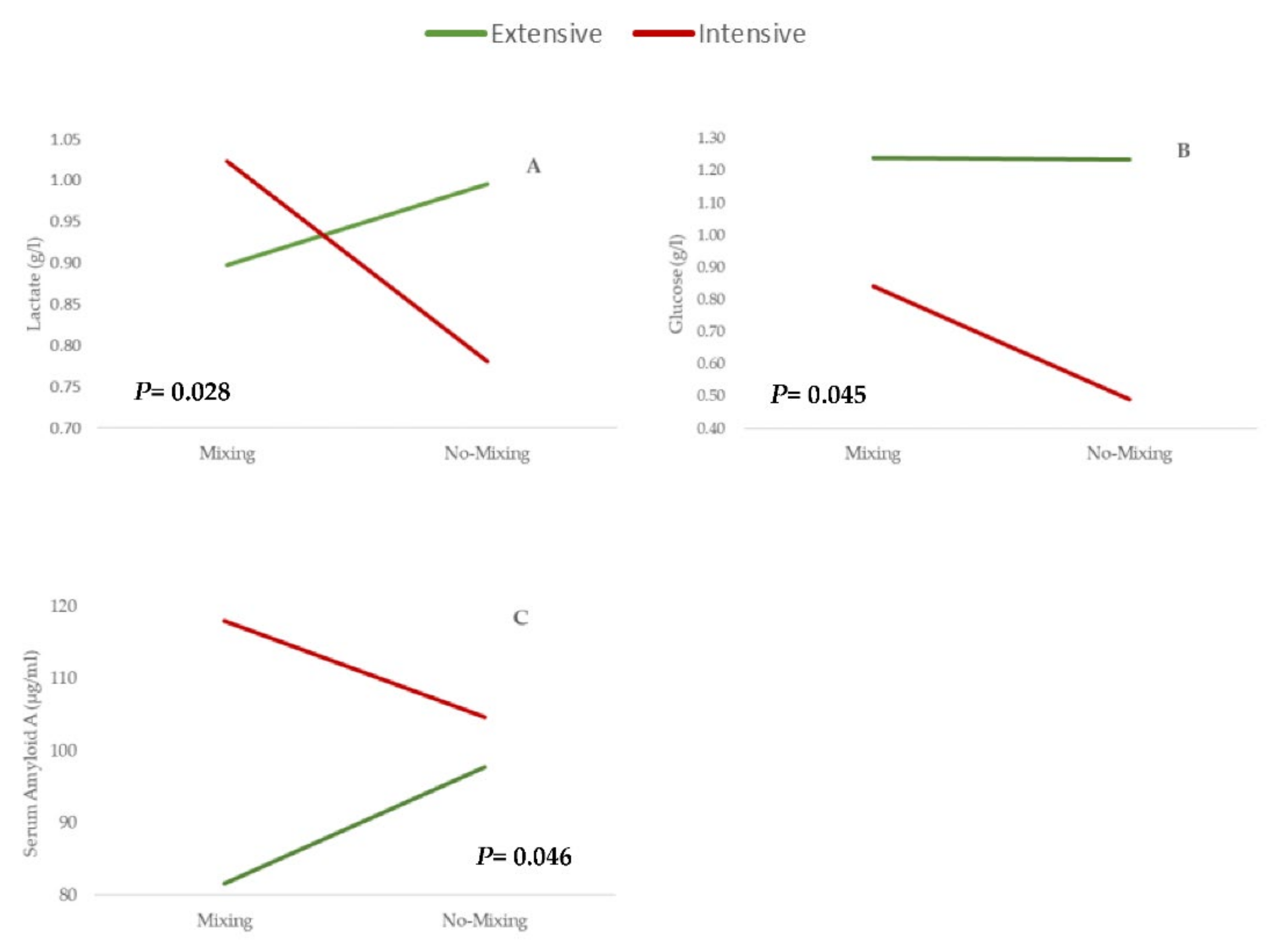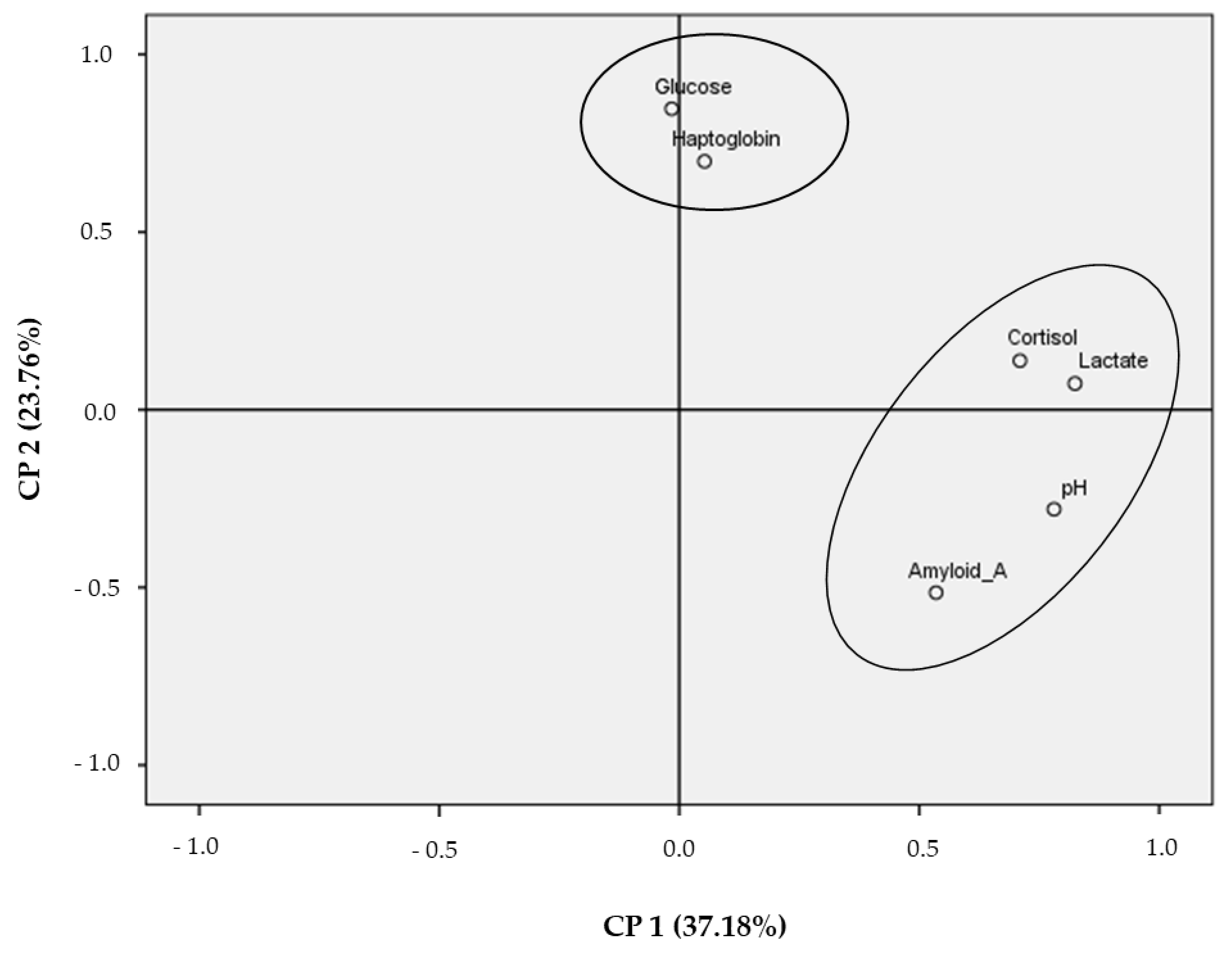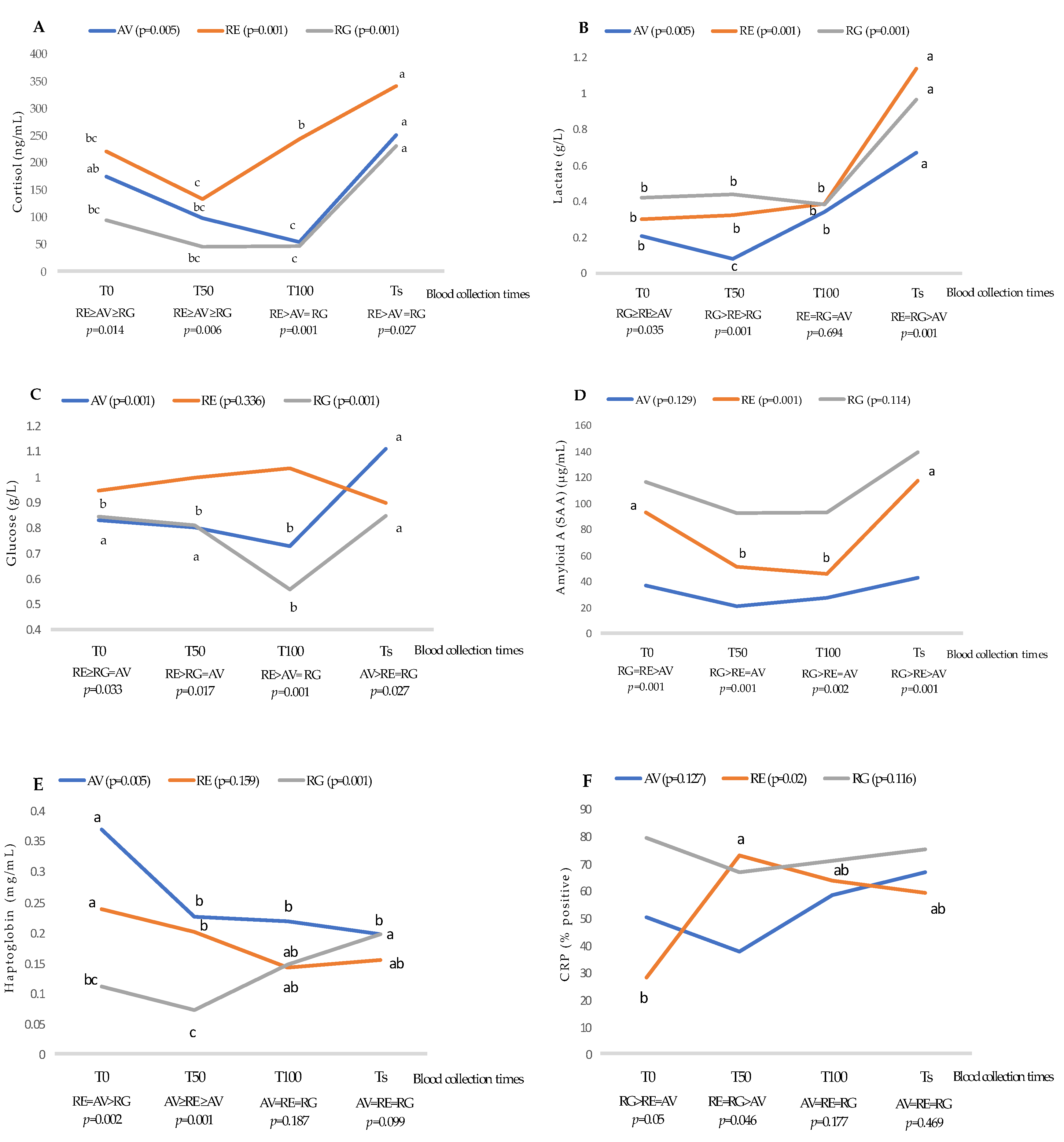Assessment of Stress by Serum Biomarkers in Calves and Their Relationship to Ultimate pH as an Indicator of Meat Quality
Abstract
Simple Summary
Abstract
1. Introduction
2. Materials and Methods
2.1. Animals and Experimental Management
2.2. Blood Collection
2.3. Blood Biochemical and Physiological Parameters
- Stress hormone: cortisol (C) was assayed by the competitive Enzyme-Linked Immunosorbent Assay (ELISA), i.e., the kit ADI-900-071 from Enzo Life Sciences (Lausen, Switzerland). The measurements were made using a colorimetric method, which detects the final concentration of cortisol conjugated with alkaline phosphatase at 405 nm. Absorbance was measured in a UV/Vis spectrophotometer for microplates (Multiskan GO, Thermo Scientific™, Vantaa, Finland).
- Biomarkers of the energetic metabolism: Both the lactate (L) and glucose (G) parameters were analyzed using enzymatic-ultraviolet determinations kits, based on the quantifications of final NADH or NADPH produced after enzymatic digestions (R-Biopharm, Darmstadt, Germany). The readings were taken at 340 nm absorbance with a Cary 60 UV-Vis Spectrophotometer (Agilent Technologies ™, Santa Clara, United states).
- Biomarkers of the inflammatory process: serum amyloid A (SAA), haptoglobin (HP), and C-reactive protein (CRP). SAA was determined by a colorimetric sandwich ELISA kit (Phase serum amyloid A, Tridelta Ltd., Maynooth, County Kildare, Ireland). The spectrophotometric measurements were made in a UV/Vis spectrophotometer for microplates (Multiskan GO, Thermo Scientific™) at 450 nm absorbance while the assessment of Hp was carried out using a colorimetric enzymatic kit assay (Phase haptoglobin Assay, Tridelta Ltd., Maynooth, County Kildare, Ireland). The measurements were made in a spectrophotometer at 630 nm absorbance (Multiskan GO, Thermo Scientific™). The assessment of the CRP was carried out by a kit test in order to discriminate serum CRP-positive samples (CRP ≥ 6 mg/L) (Biosystems C-Reactive protein), based on the agglutination of latex particles coated with a C-reactive anti-protein.
2.4. Meat Ultimate pH (pHu)
2.5. Statistical Analysis
3. Results and Discussion
3.1. Biomarkers at Slaughtering Time (Ts)
3.1.1. Stress Hormone
3.1.2. Energetic Metabolism Biomarkers
Inflammatory Process Biomarkers
Multivariate Analysis
3.2. Effect of Blood Collection Times on Serum Biomarkers by Breed
4. Conclusions
Author Contributions
Funding
Institutional Review Board Statement
Data Availability Statement
Acknowledgments
Conflicts of Interest
References
- Gregory, N.G. Animal welfare at markets and during transport and slaughter. Meat Sci. 2008, 80, 2–11. [Google Scholar] [CrossRef] [PubMed]
- Romero, P.M.H.; Uribe-Velásquez, L.F.; Sánchez, V.J.A. Stress biomarkers as indicators of animal welfare in cattle beef farming. Biosalud 2011, 10, 71–87. [Google Scholar]
- Lu, X.; Zhang, Y.; Qin, L.; Ma, W.; Zhu, L.; Luo, X. Association of ultimate pH and stress-related blood variables in cattle. Meat Sci. 2018, 139, 228–230. [Google Scholar] [CrossRef] [PubMed]
- Mach, N.; Bach, A.; Velarde, A.; Devant, M. Association between animal, transportation, slaughterhouse practices, and meat pH in beef. Meat Sci. 2008, 78, 232–238. [Google Scholar] [CrossRef]
- Oliván, M.; González, J.; Bassols, A.; Díaz, F.; Carreras, R.; Mainau, E.; Arroyo, L.; Peña, R.; Potes, Y.; Coto-Montes, A.; et al. Effect of sex and RYR1 gene mutation on the muscle proteomic profile and main physiological biomarkers in pigs at slaughter. Meat Sci. 2018, 141, 81–90. [Google Scholar] [CrossRef]
- Peña, F.; Avilés, C.; Domenech, V.; González, A.; Martínez, A.; Molina, A. Effects of stress by unfamiliar sounds on carcass and meat traits in bulls from three continental beef cattle breeds at different ageing times. Meat Sci. 2014, 98, 718–725. [Google Scholar] [CrossRef]
- Plusquellec, P.; Bouissou, M.F. Behavioural characteristics of two dairy breeds of cows selected (Hérens) or not (Brune des Alpes) for fighting and dominance ability. Appl. Anim. Behav. Sci. 2001, 72, 1–21. [Google Scholar] [CrossRef]
- Muchenje, V.; Dzama, K.; Chimonyo, M.; Strydom, P.E.; Raats, J.G. Relationship between pre-slaughter stress responsiveness and beef quality in three cattle breeds. Meat Sci. 2009, 81, 653–657. [Google Scholar] [CrossRef]
- Mota-Rojas, D.; Becerril, M.; Lemus, C.; Sánchez, P.; González, M.; Olmos, S.A.; Ramírez, R.; Alonso-Spilsbury, M. Effects of mid-summer transport duration on pre- and post-slaughter performance and pork quality in Mexico. Meat Sci. 2006, 73, 404–412. [Google Scholar] [CrossRef]
- Schaefer, A.L.; Jones, S.D.M.; Stanley, R.W. The use of electrolyte solutions for reducing transport stress. J. Anim. Sci. 1997, 75, 258–265. [Google Scholar] [CrossRef] [PubMed]
- Tadich, N.; Gallo, C.; Bustamante, H.; Schwerter, M.; Van Schaik, G. Effects of transport and lairage time on some blood constituents of Friesian-cross steers in Chile. Livest. Prod. Sci. 2005, 93, 223–233. [Google Scholar] [CrossRef]
- De Jong, I.C.; Prelle, I.T.; Van De Burgwal, J.A.; Lambooij, E.; Korte, S.M.; Blokhuis, H.J.; Koolhaas, J.M. Effects of rearing conditions on behavioural and physiological responses of pigs to preslaughter handling and mixing at transport. Can. J. Anim. Sci. 2000, 80, 451–458. [Google Scholar] [CrossRef]
- Sullivan, K.F.; Mader, T.L. Managing Heat Stress Episodes in Confined Cattle. Vet. Clin. North Am. Food Anim. Pract. 2018, 34, 325–339. [Google Scholar] [CrossRef]
- Bøe, K.E.; Færevik, G. Grouping and social preferences in calves, heifers and cows. Appl. Anim. Behav. Sci. 2003, 80, 175–190. [Google Scholar] [CrossRef]
- Arthington, J.D.; Eicher, S.D.; Kunkle, W.E.; Martin, F.G. Effect of transportation and commingling on the acute-phase protein response, growth, and feed intake of newly weaned beef calves. J. Anim. Sci. 2003, 81, 1120–1125. [Google Scholar] [CrossRef] [PubMed]
- Disanto, C.; Celano, G.; Varvara, M.; Fusiello, N.; Fransvea, A.; Bozzo, G.; Celano, G.V. Stress factors during cattle slaughter. Ital. J. Food Saf. 2014, 3, 1682. [Google Scholar] [CrossRef] [PubMed][Green Version]
- Schalk, C.; Pfaffinger, B.; Schmucker, S.; Weiler, U.; Stefanski, V. Effects of repeated social mixing on behavior and blood immune cells of group-housed pregnant sows (Sus scrofa domestica). Livest. Sci. 2018, 217, 148–156. [Google Scholar] [CrossRef]
- Marco-Ramell, A.; Pato, R.; Peña, R.; Saco, Y.; Manteca, X.; de la Torre, J.L.R.; Bassols, A. Identification of serum stress biomarkers in pigs housed at different stocking densities. Vet. J. 2011, 190, e66–e71. [Google Scholar] [CrossRef] [PubMed]
- Solano, J.; Galindo, F.; Orihuela, A.; Galina, C.S. The effect of social rank on the physiological response during repeated stressful handling in Zebu cattle (Bos indicus). Physiol. Behav. 2004, 82, 679–683. [Google Scholar] [CrossRef]
- Alvez, P.; Quintans, G.; Hötzel, M.J.; Ungerfeld, R. Two-step weaning in beef calves: Permanence of nose flaps for 7 or 21 days does not influence the behaviour response. Anim. Prod. Sci. 2016, 56, 866–870. [Google Scholar] [CrossRef]
- O’Loughlin, A.; McGee, M.; Doyle, S.; Earley, B. Biomarker responses to weaning stress in beef calves. Res. Vet. Sci. 2014, 97, 458–463. [Google Scholar] [CrossRef]
- Chrousos, G.P. Stress and disorders of the stress system. Nat. Rev. Endocrinol. 2009, 5, 374. [Google Scholar] [CrossRef]
- McEwen, B.S. Central effects of stress hormones in health and disease: Understanding the protective and damaging effects of stress and stress mediators. Eur. J. Pharmacol. 2008, 583, 174–185. [Google Scholar] [CrossRef]
- Mpakama, T.; Chulayo, A.Y.; Muchenje, V. Bruising in slaughter cattle and its relationship with creatine kinase levels and beef quality as affected by animal related factors. Asian Australas. J. Anim. Sci. 2014, 27, 717. [Google Scholar] [CrossRef]
- Cooper, C.A.C.O.; Evans, A.C.O.; Cook, S.; Rawlings, N.C. Cortisol, progesterone and β-endorphin response to stress in calves. Can. J. Anim. Sci. 1995, 75, 197–201. [Google Scholar] [CrossRef]
- Crookshank, H.R.; Elissalde, M.H.; White, R.G.; Clanton, D.C.; Smalley, H.E. Effect of transportation and handling of calves upon blood serum composition. J. Anim. Sci. 1979, 48, 430–435. [Google Scholar] [CrossRef] [PubMed]
- Mitchell, G.; Hattingh, J.; Ganhao, M. Stress in cattle assessed after handling, after transport and after slaughter. Vet. Rec. 1988, 123, 201–205. [Google Scholar] [CrossRef]
- Tothova, C.S.; Nagy, O.; Kovac, G. Acute phase proteins and their use in the diagnosis of diseases in ruminants: A review. Vet. Med. 2014, 59, 163–180. [Google Scholar] [CrossRef]
- Mapama, I.G.P. Ternera Asturiana. Available online: https://www.mapa.gob.es/es/alimentacion/temas/calidad-agroalimentaria/calidad-diferenciada/dop/carnes/IGP_Ternera_Asturiana.aspx (accessed on 20 January 2021).
- EC, I.G.P. “Ternera Gallega”. Available online: https://www.mapa.gob.es/es/alimentacion/temas/calidad-agroalimentaria/doue_c_130_10_030596_tcm30-521273.pdf (accessed on 20 January 2021).
- Mapa, I.G.P. Carne de Retinto. Available online: https://www.mapa.gob.es/es/ganaderia/temas/zootecnia/razas-ganaderas/razas/informacion/ (accessed on 20 January 2021).
- Mercasa. Carnes y Productos Cárnicos; Distribución y Consumo; MERCASA: Madrid, Spain, 2017. [Google Scholar]
- Mapama. Programa de Mejora de la Raza de Vacuno Retinta; Distribución y Consumo; Asociación de raza bovina Retinta: Madrid, Spain, 2017. [Google Scholar]
- Acruga, A. Available online: https://acruga.com/ (accessed on 20 January 2021).
- Pateiro, M.; Lorenzo, J.M.; Diaz, S.; Gende, J.A.; Fernandez, M.; Gonzalez, J.; Garcia, L.; Rial, F.J.; Franco, D. Meat quality of veal: Discriminatory ability of weaning status. Spanish J. Agric. Res. 2013, 4, 1044–1056. [Google Scholar] [CrossRef]
- Aldai, N.; Nájera, A.I.; Martínez, A.; Celaya, R.; Osoro, K. Correlation between carcass conformation and fat cover degree, and muscle fatty acid profile of yearling bulls depending on breed and mh-genotype. Livest. Sci. 2007, 107, 199–212. [Google Scholar] [CrossRef]
- Aldai, N.; Murray, B.E.; Oliván, M.; Martínez, A.; Troy, D.J.; Osoro, K.; Nájera, A.I. The influence of breed and mh-genotype on carcass conformation, meat physico-chemical characteristics, and the fatty acid profile of muscle from yearling bulls. Meat Sci. 2006, 72, 486–495. [Google Scholar] [CrossRef] [PubMed]
- Mouresan, E.F.; González-Rodríguez, A.; Cañas-Álvarez, J.J.; Díaz, C.; Altarriba, J.; Baro, J.A.; Piedrafita, J.; Molina, A.; Toro, M.A.; Varona, L. On the haplotype diversity along the genome in Spanish beef cattle populations. Livest. Sci. 2017, 201, 30–33. [Google Scholar] [CrossRef]
- Piedrafita, J.; Quintanilla, R.; Sañudo, C.; Olleta, J.L.; Campo, M.M.; Panea, B.; Oliván, M.C. Carcass quality of 10 beef cattle breeds of the Southwest of Europe in their typical production systems. Livest. Prod. Sci. 2003, 82, 1–13. [Google Scholar] [CrossRef]
- Averós, X.; Martín, S.; Riu, M.; Serratosa, J.; Gosálvez, L.F. Stress response of extensively reared young bulls being transported to growing-finishing farms under Spanish summer commercial conditions. Livest. Sci. 2008, 119, 174–182. [Google Scholar] [CrossRef]
- Tadich, N.; Gallo, C.; Echeverría, R.; Van Schaik, G. Efecto del ayuno durante dos tiempos de confinamiento y de transporte terrestre sobre algunas variables sanguíneas indicadoras de estrés en novillos. Arch. Med. Vet. 2003, 35, 171–185. [Google Scholar] [CrossRef]
- Tadich, N.; Tejeda, C.; Bastias, S.; Rosenfeld, C.; Green, L.E. Nociceptive threshold, blood constituents and physiological values in 213 cows with locomotion scores ranging from normal to severely lame. Vet. J. 2013, 197, 401–405. [Google Scholar] [CrossRef]
- Chen, Y.; Arsenault, R.; Napper, S.; Griebel, P. Models and Methods to Investigate Acute Stress Responses in Cattle. Animals 2015, 5, 1268–1295. [Google Scholar] [CrossRef] [PubMed]
- Poleti, M.D.; DeRijk, R.H.; Rosa, A.F.; Moncau, C.T.; Oliveira, P.S.; Coutinho, L.L.; Eler, J.P.; Balieiro, J.C.C. Genetic variants in glucocorticoid and mineralocorticoid receptors are associated with concentrations of plasma cortisol, muscle glycogen content, and meat quality traits in male Nellore cattle. Domest. Anim. Endocrinol. 2015, 51, 105–113. [Google Scholar] [CrossRef] [PubMed]
- Curley, K.O., Jr. Influence of Temperament on Bovine Hypothalamic-Pituitary-Adrenal Function. Doctoral dissertation, Texas A&M University, College Station, TX, USA, 2006. [Google Scholar]
- Grandin, T. Handling Methods and Facilities to Reduce Stress on Cattle; Veterinary Clinics of North America: Food Animal Practice. Vet. Clin. N. Am. Food Anim. Pract. 1998, 14, 325–341. [Google Scholar]
- King, D.A.; Schuehle Pfeiffer, C.E.; Randel, R.D.; Welsh, T.H.; Oliphint, R.A.; Baird, B.E.; Curley, K.O.; Vann, R.C.; Hale, D.S.; Savell, J.W. Influence of animal temperament and stress responsiveness on the carcass quality and beef tenderness of feedlot cattle. Meat Sci. 2006, 74, 546–556. [Google Scholar] [CrossRef]
- Rodríguez-Vázquez, R.; Mato, A.; López-Pedrouso, M.; Franco, D.; Sentandreu, M.A.; Zapata, C. Measuring quantitative proteomic distance between Spanish beef breeds. Food Chem. 2020, 315, 126293. [Google Scholar] [CrossRef]
- Muchenje, V.; Dzama, K.; Chimonyo, M.; Strydom, P.E.; Hugo, A.; Raats, J.G. Some biochemical aspects pertaining to beef eating quality and consumer health: A review. Food Chem. 2009, 112, 279–289. [Google Scholar] [CrossRef]
- Eusebi, P.G.; Sevane, N.; Cortés, O.; Contreras, E.; Cañon, J.; Dunner, S. Aggressive behavior in cattle is associated with a polymorphism in the MAOA gene promoter. Anim. Genet. 2020, 51, 14–21. [Google Scholar] [CrossRef] [PubMed]
- Alsemgeest, S.P.M.; Lambooy, I.E.; Wierenga, H.K.; Dieleman, S.J.; Meerkerk, B.; Van Ederen, A.M.; Niewold, T.A. Influence of physical stress on the plasma concentration of serum amyloid-A (SAA) and haptoglobin (Hp) in calves. Vet. Q. 1995, 17, 9–12. [Google Scholar] [CrossRef]
- Shaw, F.D.; Tume, R.K. The assessment of pre-slaughter and slaughter treatments of livestock by measurement of plasma constituents—a review of recent work. Meat Sci. 1992, 32, 311–329. [Google Scholar] [CrossRef]
- de la Lama, G.C.M.; Villarroel, M.; María, G.A. Livestock transport from the perspective of the pre-slaughter logistic chain: A review. Meat Sci. 2014, 98, 9–20. [Google Scholar] [CrossRef] [PubMed]
- Lomborg, S.R.; Nielsen, L.R.; Heegaard, P.M.H.; Jacobsen, S. Acute phase proteins in cattle after exposure to complex stress. Vet. Res. Commun. 2008, 32, 575–582. [Google Scholar] [CrossRef]
- Smith, B.I.; Kauffold, J.; Sherman, L. Serum haptoglobin concentrations in dai...le with lameness due to claw disorders. Vet. J. 2010, 186, 162–165. [Google Scholar] [CrossRef] [PubMed]
- Murata, H.; Shimada, N.; Yoshioka, M. Current research on acute phase proteins in veterinary diagnosis: An overview. Vet. J. 2004, 168, 28–40. [Google Scholar] [CrossRef]
- Ceciliani, F.; Ceron, J.J.; Eckersall, P.D.; Sauerwein, H. Acute phase proteins in ruminants. J. Proteom. 2012, 75, 4207–4231. [Google Scholar] [CrossRef] [PubMed]
- Joshi, V.; Gupta, V.K.; Bhanuprakash, A.G.; Mandal, R.S.K.; Dimri, U.; Ajith, Y. Haptoglobin and serum amyloid A as putative biomarker candidates of naturally occurring bovine respiratory disease in dairy calves. Microb. Pathog. 2018, 116, 33–37. [Google Scholar] [CrossRef] [PubMed]
- Bravo, V.; Gallo, C.; Acosta-Jamett, G. Effects of short transport and prolonged fasting in beef cattles. Animals 2018, 8, 170–178. [Google Scholar] [CrossRef]
- Coombes, S.V.; Gardner, G.E.; Pethick, D.W.; McGilchrist, P. The impact of beef cattle temperament assessed using flight speed on muscle glycogen, muscle lactate and plasma lactate concentrations at slaughter. Meat Sci. 2014, 98, 815–821. [Google Scholar] [CrossRef]
- Bourguet, C.; Deiss, V.; Gobert, M.; Durand, D.; Boissy, A.; Terlouw, E.M.C. Characterising the emotional reactivity of cows to understand and predict their stress reactions to the slaughter procedure. Appl. Anim. Behav. Sci. 2010, 125, 9–21. [Google Scholar] [CrossRef]
- Gruber, S.L.; Tatum, J.D.; Engle, T.E.; Chapman, P.L.; Belk, K.E.; Smith, G.C. Relationships of behavioral and physiological symptoms of preslaughter stress to beef longissimus muscle tenderness. J. Anim. Sci. 2010, 88, 1148–1159. [Google Scholar] [CrossRef] [PubMed]
- Probst, J.K.; Spengler, N.A.; Hillmann, E.; Kreuzer, M.; Koch-Mathis, M.; Leiber, F. Relationship between stress-related exsanguination blood variables, vocalisation, and stressors imposed on cattle between lairage and stunning box under conventional abattoir conditions. Livest. Sci. 2014, 164, 154–158. [Google Scholar] [CrossRef]
- Schrödl, W.; Büchler, R.; Wendler, S.; Reinhold, P.; Muckova, P.; Reindl, J.; Rhode, H. Biomarkers (APP) human and veterinary. Proteomic Clin. Appl. 2016, 10, 1077–1092. [Google Scholar] [CrossRef]
- Werner, M.; Hepp, C.; Soto, C.; Gallardo, P.; Bustamante, H.; Gallo, C. Effects of a long distance transport and subsequent recovery in recently weaned crossbred beef calves in Southern Chile. Livest. Sci. 2013, 152, 42–46. [Google Scholar] [CrossRef]
- Bourguet, C.; Deiss, V.; Boissy, A.; Terlouw, E.C. Young Blond d’Aquitaine, Angus and Limousin bulls differ in emotional reactivity: Relationships with animal traits, stress reactions at slaughter and post-mortem muscle metabolism. Appl. Anim. Behav. Sci. 2015, 164, 41–55. [Google Scholar] [CrossRef]
- Díaz, F.; Díaz-Luis, A.; Sierra, V.; Diñeiro, Y.; González, P.; García-Torres, S.; Oliván, M. What functional proteomic and biochemical analysis tell us about animal stress in beef? J. Proteom. 2020, 218, 103722. [Google Scholar] [CrossRef]
- Ferguson, D.M.; Warner, R.D. Have we underestimated the impact of pre-slaughter stress on meat quality in ruminants? Meat Sci. 2008, 80, 12–19. [Google Scholar] [CrossRef] [PubMed]
- Ijaz, M.; Li, X.; Zhang, D.; Hussain, Z.; Ren, C.; Bai, Y.; Zheng, X. Association between meat color of DFD beef and other quality attributes. Meat Sci. 2020, 161, 107954. [Google Scholar] [CrossRef]
- Franco, D.; Mato, A.; Salgado, F.J.; López-Pedrouso, M.; Carrera, M.; Bravo, S.; Parrado, M.; Gallardo, J.M.; Zapata, C. Tackling proteome changes in the longissimus thoracis bovine muscle in response to pre-slaughter stress. J. Proteom. 2015, 122, 73–85. [Google Scholar] [CrossRef] [PubMed]
- de la Cruz-Cruz, L.A.; Bonilla-Jaime, H.; Orozco-Gregorio, H.; Tarazona-Morales, A.M.; Ballesteros-Rodea, G.; Roldan-Santiago, P.; Vargas-Romero, J.M. Effects of weaning on the stress responses and productivity of water buffalo in different breeding systems: A review. Livest. Sci. 2019, 226, 73–81. [Google Scholar] [CrossRef]
- Hambrecht, E.; Eissen, J.J.; Newman, D.J.; Smits, C.H.M.; Verstegen, M.W.A.; Den Hartog, L.A. Preslaughter handling effects on pork quality and glycolitic potential in two muscles differing in fiber type composition. J. Anim. Sci. 2005, 83, 900–907. [Google Scholar] [CrossRef] [PubMed]
- Chulayo, A.Y.; Bradley, G.; Muchenje, V. Effects of transport distance, lairage time and stunning efficiency on cortisol, glucose, HSPA1A and how they relate with meat quality in cattle. Meat Sci. 2016, 117, 89–96. [Google Scholar] [CrossRef]
- 2004 (CE); REGULATION, C.; December; 22, N. 1/2005 of on the Protection of Animals during Transport and Related Operations and Amending Directives 64/432/EEC and 93/119/EC. Available online: https://www.europarl.europa.eu/RegData/etudes/STUD/2018/621853/EPRS_STU(2018)621853_EN.pdf (accessed on 10 November 2020).
- Transport., R. (EC) N. 1255/97 and R.D. 542/2016 of 25 N. 2016 on Animal Health and Protection Rules during No Title. Available online: https://www.boe.es/eli/es/rd/2016/11/25/542/con (accessed on 10 November 2020).
- Council Directive 93/119/EC. Council Directive 93/119/EC of 22 December 1993 on the Protection of Animals at the Time of Slaughter or Killing. 1993. Available online: https://eur-lex.europa.eu/legal-content/EN/TXT/PDF/?uri=CELEX:31993L0119&from=EN (accessed on 10 November 2020).




| Breed (B) | Farm Management (F) | Pre-Slaughter Handing (PSH) | Interactions | |||||||||||
|---|---|---|---|---|---|---|---|---|---|---|---|---|---|---|
| AV | RE | RG | p-Value | E | I | p-Value | M | NM | p-Value | B×F | B×PSH | F×PSH | SEM | |
| Cortisol (ng/mL) | 251.45 b | 341.05 a | 230.45 b | 0.027 | 268.54 | 208.54 | 0.238 | 236.62 | 240.45 | 0.897 | 0.004 | 0.364 | 0.295 | 19.648 |
| Lactate (g/L) | 0.671 b | 1.150 a | 0.958 a | 0.001 | 0.919 | 0.883 | 0.603 | 0.937 | 0.865 | 0.300 | 0.001 | 0.925 | 0.028 | 0.0483 |
| Glucose (g/L) | 1.112 a | 0.895 ab | 0.847 b | 0.027 | 1.236 | 0.666 | 0.001 | 1.106 | 0.901 | 0.038 | 0.001 | 0.148 | 0.045 | 0.0659 |
| Serum Amyloid A (µg/mL) | 42.69 c | 117.20 b | 139.21 a | 0.001 | 104.51 | 106.21 | 0.828 | 101.95 | 108.79 | 0.382 | 0.001 | 0.001 | 0.046 | 7.187 |
| Haptoglobin (mg/mL) | 0.196 | 0.164 | 0.196 | 0.099 | 0.326 | 0.171 | 0.001 | 0.221 | 0.276 | 0.325 | 0.001 | 0.006 | 0.076 | 0.0107 |
| CRP test (% positive) | 66.67 | 59.09 | 75.00 | 0.469 | 50.96 | 62.23 | 0.232 | 58.00 | 54.04 | 0.662 | 0.792 | 0.329 | 0.606 | 5.700 |
| pHu | 5.48 c | 5.79 a | 5.62 b | 0.000 | 5.63 | 5.65 | 0.678 | 5.64 | 5.64 | 0.512 | 0.512 | 0.276 | 0.698 | 0.017 |
| SAA | Cortisol | Lactate | Glucose | Haptoglobin | pHu | |
|---|---|---|---|---|---|---|
| SAA | 1 | |||||
| Cortisol | 0.12 | 1 | ||||
| Lactate | 0.342 ** | 0.430 *** | 1 | |||
| Glucose | −0.383 *** | 0.01 | 0,04 | 1 | ||
| Haptoglobin | −0.06 | −0.02 | 0.06 | 0.333 ** | 1 | |
| pHu | 0.468 *** | 0.400 *** | 0.492 *** | −0.15 | −0.17 | 1 |
Publisher’s Note: MDPI stays neutral with regard to jurisdictional claims in published maps and institutional affiliations. |
© 2021 by the authors. Licensee MDPI, Basel, Switzerland. This article is an open access article distributed under the terms and conditions of the Creative Commons Attribution (CC BY) license (https://creativecommons.org/licenses/by/4.0/).
Share and Cite
García-Torres, S.; Cabeza de Vaca, M.; Tejerina, D.; Romero-Fernández, M.P.; Ortiz, A.; Franco, D.; Sentandreu, M.A.; Oliván, M. Assessment of Stress by Serum Biomarkers in Calves and Their Relationship to Ultimate pH as an Indicator of Meat Quality. Animals 2021, 11, 2291. https://doi.org/10.3390/ani11082291
García-Torres S, Cabeza de Vaca M, Tejerina D, Romero-Fernández MP, Ortiz A, Franco D, Sentandreu MA, Oliván M. Assessment of Stress by Serum Biomarkers in Calves and Their Relationship to Ultimate pH as an Indicator of Meat Quality. Animals. 2021; 11(8):2291. https://doi.org/10.3390/ani11082291
Chicago/Turabian StyleGarcía-Torres, Susana, María Cabeza de Vaca, David Tejerina, María Pilar Romero-Fernández, Alberto Ortiz, Daniel Franco, Miguel Angel Sentandreu, and Mamen Oliván. 2021. "Assessment of Stress by Serum Biomarkers in Calves and Their Relationship to Ultimate pH as an Indicator of Meat Quality" Animals 11, no. 8: 2291. https://doi.org/10.3390/ani11082291
APA StyleGarcía-Torres, S., Cabeza de Vaca, M., Tejerina, D., Romero-Fernández, M. P., Ortiz, A., Franco, D., Sentandreu, M. A., & Oliván, M. (2021). Assessment of Stress by Serum Biomarkers in Calves and Their Relationship to Ultimate pH as an Indicator of Meat Quality. Animals, 11(8), 2291. https://doi.org/10.3390/ani11082291








